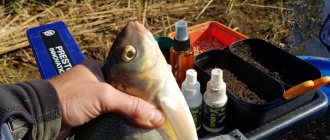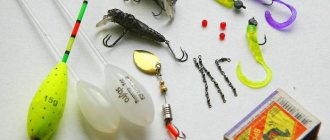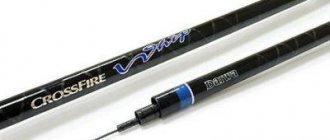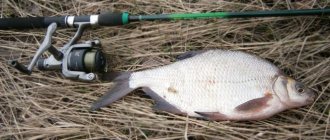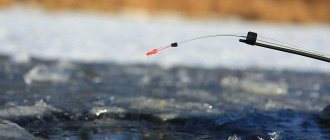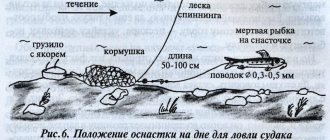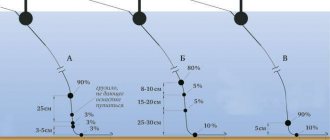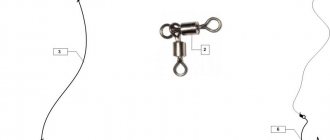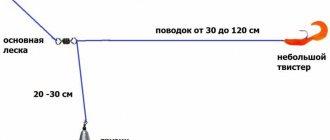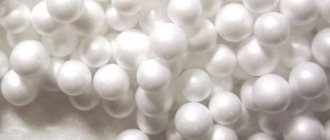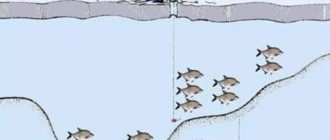Bream is a fairly large fish (mostly individuals weigh five or six kilograms). As a rule, it is found only in fresh water, in holes that are located next to snags. As soon as the bream finishes spawning and becomes very hungry, anglers begin to catch it.
From the second half of June until the beginning of August, golden-sided fish bite only at night, and only from the last month of summer until the very frosts do they again willingly peck at the bait that is set by those who like to fish on a feeder.
This equipment is universal, so it can be used both in places where there is no current, and in reservoirs in which it is present. In this section, fishing for bream on a feeder will be discussed in detail, and those who are not familiar with it will be able to find out what it is.
The most important thing about the feeder (English donk)
Fishermen have been fishing for bream since ancient times. Then it was customary to put a donka on it - a throwaway. However, today the most popular fishing method is feeders. They can be placed absolutely anywhere: on a lake, reservoir or river.
A feeder is an improved universal equipment that includes groundbait and bait. Thanks to the first, flat inhabitants of reservoirs are attracted, and the second is necessary to influence fish appetite.
Other ways to catch bream
The popularity of bream fishing from the shore is a consequence of the abundance of this species. In particular, bream fishing on the Volga is the main activity of local fishing enthusiasts.
Hunting on the river involves fishing in various conditions; you can catch bream in the current only by using special fishing gear adapted for this purpose.
Bottom fishing rods
This type of gear is the most common among fishing enthusiasts and is used to catch bottom species. In current fishing conditions, they are adapted in such a way that apparent interference is used to increase the efficiency of the process.
The point of such fishing is to deliver the bait to the place where the fish are most likely to be, taking into account external conditions. And to increase the chances of success, you need to deliver the bait to the same place.
Simple donka
Installation of a donkey includes the required elements:
- main line;
- sinker-feeder of various designs;
- hooks, the design and size of which are selected depending on the type and size of the intended trophies.
A popular method of installing a bottom fishing rod with a feeder.
The designs of individual elements can have a variety of embodiments depending on the preferences of the manufacturer.
Feeder devices
In principle, a feeder is an improved donka, for which a specially designed fishing rod has been invented. It is characterized by increased strength and bending ability. The main design difference of the feeder blank is the presence of a set of tips (the upper link of the rod is replaceable) of varying elasticity and ability to bear loads. This allows you to reconfigure the tackle depending on the fishing conditions, the required casting distance, and the weight of the feeder used.
A set of accessories for effective feeder fishing.
The peculiarity of a fishing rod of this design allows you to successfully catch bream in the current at long distances from the shore. The main condition for success when fishing with a feeder is that the fisherman masters the technique of accurately casting the feeder and installing it in the same place during the fishing trip.
How to choose a fishing rod?
Since bream is an inhabitant of deep-sea rivers and lakes, it is advisable to select rods for it that consist of carbon fibers (carbon). Ideally, their top should have a test load of around one hundred grams. These are fishing rods for long casting and, therefore, provide the opportunity for a good bite.
It is worth considering the length of the feeder rod. Its average value, which it is advisable to take, should be three or three and a half meters . It is necessary to select it based on the depth and volume in the fishing area (for small bodies of water, shorter rods should be used and vice versa).
Another important factor that plays a big role in this matter is coastal vegetation. If there is too much of it near the shore, it is recommended to use a short rod, this will help not to catch it anywhere at the time of casting.
How not to make a mistake when choosing a reel?
The coil should be selected according to several criteria:
- The reel must be capable of correctly balancing the tackle, so it should be selected experimentally;
- It is desirable that its gear ratio be in the range from four point eight to one to five to one. It is best to take a reel whose spool size ranges from two and a half thousand to four (depending on the distance at which casts will occur). It is also important that the spool easily accommodates a fishing line with a length of at least one hundred and fifty meters. The role of the rear or front clutch is not particularly important, but it must be in working condition. The presence of a bayrunner is not mandatory for this equipment (if it is present, it will not hurt);
- It is important to pay attention to quality . A win-win option is to purchase a reel manufactured by a well-known manufacturer. Since even inexpensive reel options from any good company are of better quality than any product from an unknown Chinese manufacturer.
Disadvantages of feeder fishing
Currently, it is fashionable to fish from the shore with a feeder, which is a bottom tackle for bream from the shore or for other fish, where the load is a feeder. Feeder rods are made for it, which are divided into five classes: picker, light feeders, medium class, “Heavy” class, “Extra” class. Each for a certain weight of prey. For feeder rods, spinning reels (carp, power, and others) are selected accordingly. The bite indicator is a soft tip of the rod, painted in a noticeable color. At night, fireflies are tied to the top so that the bite is visible. The feeders are all quite light on sale, for fishing in small currents.
All the tackle, if you take high-quality one, is also expensive. I have seen this picture more than once: they throw out ten of these fishing rods in the current, set fireflies for the night and sit all night watching them, waiting for a bite. Meanwhile, the current washes these would-be feeders close to the shore where you can’t count on catching large fish. Use such gear to fish only in bays and places with quiet currents where there are no snags.
A little about feeders
When fishing with a feeder in a reservoir where there is no current at all, most often they use a round or cylindrical feeder, the weight of which does not exceed fifty grams. To secure it, use an asymmetrical loop or paternoster.
If the ground surface is uneven, it is recommended to use rolling types of feeders. They must have an oval base or an open cone . Also in these places it is practiced to use a spring feeder to wash out complementary food more quickly.
For fishing at great depths, it is advisable to use an unshipped feeder, into which you need to add loose plant food and some worms or maggots. Donka fishing with a feeder involves immersing the latter in the water and spreading a pleasant aroma in a radius around you that attracts fish.
Feeder manufacturing technology
First of all, you need to start making the mold.
You can do this in several ways:
- Using a chisel, hollow out recesses in the boards that correspond to the shapes of future feeders;
- Make a mold using plaster. This option involves sculpting a model of the heavy component of the feeder. Then a mold is made from plaster based on the model.
After the mold is made, we begin preparing for casting, for this you need:
- Melt the metal;
- Remove scale, dirt, and debris from the molten metal;
- When using a mold made from a board, you need to put a bent mesh (blank) or several bent pieces of wire into it;
- Carefully pour the molten metal into the mold, without catching any of the installed elements;
- Remove excess remains of frozen metal from the finished feeder (when using a plaster mold, similar actions are performed).
Please note: It is quite difficult to make a metal feeder, but it can last much longer, unlike the plaster version. In addition, a gypsum feeder has poor stability on a rocky bottom surface.
Bream on a float rod
A float is rarely used specifically for catching bream. It is often caught when catching other fish, or when catching mixed fish, but pure bream fish don’t use it that much. It is better suited for river fishing than other gear. For lake fishing, you usually have to choose specific places where you can fish from rocks, cliffs and other places that allow you to get to a good depth near the shore. There will be many more such places on the river. A match fishing rod is well suited for bream, as it allows you to throw the float over a long distance and reach the bream spot. But it is only effective in standing water or on a pond.
For fishing, you should look for a small river where the bed is located twenty to thirty meters from the shore. Usually you can find a place on them both in June and in August to get close to the bream. Only long rods are used, from five to six meters. True, you should take expensive ones that weigh less. In the current, both fishing with fly rods and fishing with a Bolognese rod with rings and a reel are practiced. With the latter, you can cast the tackle a little further using a reel, but the casting range is incomparable with match fishing and is usually small.
The Cralusso Bolo and Surf float will greatly expand the angler’s capabilities. Invented in Hungary, these floats allow you to fully fish with Bolognese tackle at a great distance from the shore. They behave like a sail in the current, allowing the bait to be carried far and not washing up to the coastal zone. Bolo gives less thrust and is more suitable for intermittent retrieves, while Surf is designed to slowly “probe” every centimeter of the bottom. Skillfully handling the rod and reel, the angler is able to delicately move the bait to the right place with their help. You could even say that catching bream without these floats is almost a waste of time.
Both plant and animal baits should be used for fishing. Use sandwiches effectively. On an overgrown bottom, a float rod can be more effective than a bottom rod, since it will allow you to place the bait just above the grass or so that it does not go deep into its thickness and lies on its carpet in the bottom layer. The nozzle should ALWAYS go ahead of the float. This will lead to less chance of getting caught on the grass and is more similar to the natural behavior of food objects in the water.
When fishing for bream on a float, bait is required. It is advisable to do it some time before fishing, so that you can catch bream and not frighten it with the noise of falling bait balls. In float fishing, soil is actively used. The volume of bait in this case should be significantly larger than when fishing with a feeder - sometimes you have to throw up to a bucket for the starting feed, and if the bite is gone, throw in another half.
Match fishing for bream
You cannot bypass such a not very well-known method as match fishing for bream. It is practiced only in places where there is little or no current. Usually these are river bays, places near natural spits, capes, fenders, places with whirlpools and reverse flows, areas behind thickets of grass that dampen the force of the flow. Fishing can be especially successful at the beginning of summer, casting to places inaccessible to a regular float.
For fishing, use a classic match rod 3.9-4.2 meters long and a waggler float rigidly attached to the fishing line. As bait, they use baits that are large enough and sink quickly so that they have time to sink and not get caught by small fish. The bait is also placed quite heavy, but at a distance of about 30-40 cm from the hook. Fine-tuning the tackle in depth is also of great importance. It is very important that the nozzle lies motionless on the bottom, and the feeder hangs above it. Sufficiently long leashes are used.
Victoria Leshchenko
I've been working hard in the fishing tackle department for the past six years. I can help you assemble almost any gear.
Ask a Question
The cast is made to the baited area, and then the line is pulled to the required distance along the marker. In this case, the bait is carried out from a slingshot along a previously abandoned float.
Bream fishing and fishing take place in the same order as on the feeder. But the feeling of catching fish with thin match gear is much sharper. And the tackle itself, according to the author, is much more sporty.
Leashes
To make a leash, you can take a simple monofilament fishing line. Due to the fact that bream can see everything very well in the water, it is very important that the fishing line be of small thickness, because thick fishing line scares them.
It is very important that the leashes are long (from thirty centimeters to a meter), regardless of what equipment you decide to use for feeder fishing. You need to select the most suitable length based on the activity with which the fish bites.
If the bite is strong , you should take small leashes, and vice versa. In the case when the bites are empty or the fish behaves too cautiously, it is recommended to reduce the diameter of the leader to a minimum.
For those who want to catch a lot of big fish, it is advisable to use leashes with diameters that do not exceed a quarter of a millimeter.
Construction of a rig for catching bream on a float
The production of equipment for such a fishing rod is carried out taking into account the characteristic behavior of this fish at the time of feeding.
Arrangement of catching equipment for bream.
How to make a donka for bream
As the main fishing line for bream, you can use a monofilament with a thickness of 0.25 mm, which makes it possible to use lightweight reels of small capacity.
For leashes, you can use regular line 0.1–0.18 millimeters; with elastic modern fishing rods, its strength is quite sufficient. But fluorocarbon leashes are becoming increasingly popular; their main advantage is that they are hardly noticeable in the water. The refractive index of light in this material is close to that of water. This makes it possible to use scaffolding with a larger cross-section - 0.2 millimeters.
As an additional weight in bream installation, “under-grazing” is used - pellets weighing 1-2 grams in an amount of up to 3-4 pieces. They stabilize the position of the float during fishing in the current and help improve the recognition of bream bites.
Selection of hooks
Of course, it’s also worth devoting a little time to choosing hooks. Particular attention should be paid to their quality. Therefore, it is best to take hooks only from a trusted, popular manufacturer. As for the size of the hooks, it all depends on what size bream will be caught.
Feeder fishing for large bream involves choosing hooks of sizes seven and ten . If you plan to fish for small specimens, it is best to take hooks of numbers ten or fourteen.
Feeder rig for bream in summer
By the end of May, bream finishes spawning. After this, after two weeks, he begins to actively peck. The duration of a good bite lasts for the third decade. At this time, bream's feeling of hunger becomes especially acute.
This gives anglers an excellent chance of catching large numbers of fish. Small-sized individuals give their preference to almost everything that the bottom of the reservoir is rich in, and adult bream choose only the food that contains the most calories.
During summer bream fishing, it is best to use the following types of feeder equipment:
- Gardner loop;
- Symmetrical and asymmetrical loop;
- Accessories with tube;
The leash should be selected so that its length is at least thirty centimeters and no more than a meter. When biting bream carefully, it is necessary to lengthen it. This will allow the fish to swallow the bait deeper, and the chances of a successful hook will increase.
A hook for summer fishing should be chosen in a very small size, for the reason that, together with the use of a thin long leash, this type of hook gives excellent play on the bottom and attracts bream well.
What baits and baits does bream prefer?
When feeder fishing for bream, bait is selected according to water temperature.
If the water is cool, then bream prefers bait of animal origin:
- Dung or earthworms;
- Maggot;
- Bloodworm;
Warm water changes the preferences of these fish, and they enjoy eating plant baits, of which the following are excellent:
- Hominy;
- Pearl barley;
- Corn;
- Bread dough;
- Wheat dough that is flavored;
- Small-sized boilies.
The most important thing is to change bait as often as possible. When using bread or semolina porridge for bait, be sure to roll them into small balls with a diameter of about half a centimeter. When baiting, do not allow the tip of the hook to stick out.
The worms need to be planted in small groups and ensure that they move. Also, the hook should not be allowed to become visible. Maggots are not recommended to be used alone. It is recommended to combine it with bloodworms, since bream are big fans of this “sandwich”.
The correct attachment of bloodworms involves tying several pieces and planting them in a bunch. This type of feeder bait is universal and can be successfully used in both cold and warm water. An experienced fisherman always carries several types of bait with him.
When starting fishing, the first thing he does is put every available type of bait on the feeder. In this way, the taste preferences of bream are determined.
Lure
The lion's share in the success of fishing using a feeder is considered to be feeding. Bream wander in schools in the waters of a reservoir in an attempt to find food, therefore, in order to retain fish in places where the equipment is cast, it is necessary to provide them with an abundance of tasty food.
Today, the production of mixtures for baiting bream is well developed, which are sold in any specialized store. Anyone can easily choose a bait that will be ideal for their fish.
Catching bream without worrying about preparing food is convenient for many fishermen. Also, thanks to this approach, time costs are significantly reduced.
However, those wishing to purchase ready-made bait should be prepared for the fact that this will require them to spend more money than preparing the mixture at home.
It is worth noting that any ready-made bait is not at all suitable for fishing, the target of which is large bream. They will make quick work of it and then go in search of more food. Of course, you may catch a couple of large fish, but then only small things will bite.
Therefore, if you want to get a trophy in the form of a large bream, it is best to make the bait yourself.
You can use a variety of ingredients to bait bream:
- Boiled pearl barley;
- Millet groats;
- Cereals;
- Corn grits, etc.
Starting from August, chopped worms, bloodworms and maggots must be mixed into complementary foods. This bait will attract bream until mid-autumn.
